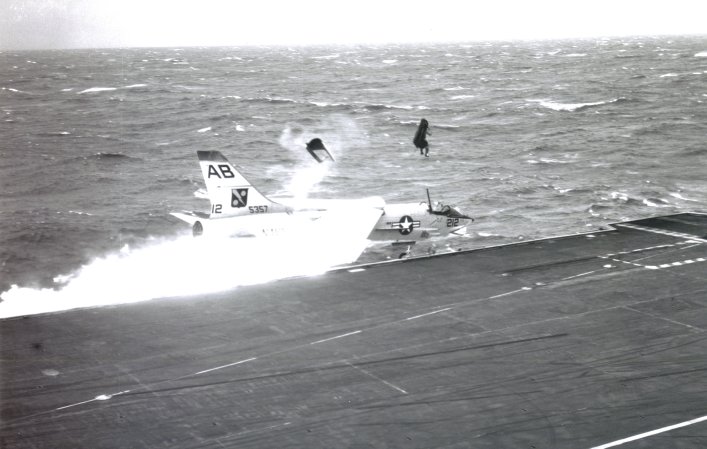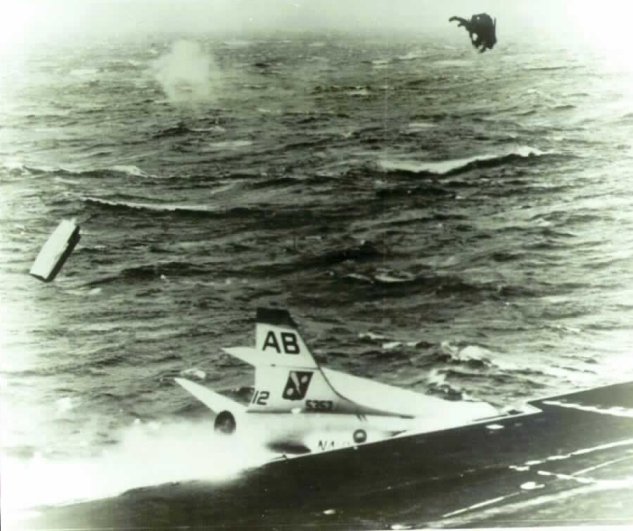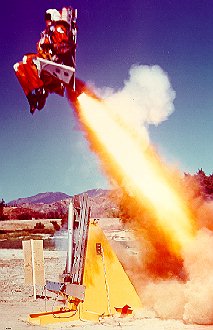Sie sind nicht angemeldet.
Lieber Besucher, herzlich willkommen bei: . Falls dies Ihr erster Besuch auf dieser Seite ist, lesen Sie sich bitte die Hilfe durch. Dort wird Ihnen die Bedienung dieser Seite näher erläutert. Darüber hinaus sollten Sie sich registrieren, um alle Funktionen dieser Seite nutzen zu können. Benutzen Sie das Registrierungsformular, um sich zu registrieren oder informieren Sie sich ausführlich über den Registrierungsvorgang. Falls Sie sich bereits zu einem früheren Zeitpunkt registriert haben, können Sie sich hier anmelden.


Zitat
This photo is one of a series of nine photographs taken on 21 October 1961. The pilot LT JG Kryway's landing gear on his F8U-1 failed on landing and the collapsed gear had sprayed debris into the fuel tanks starting a major conflagration under the aircraft. The hook failed to engage any of the cross deck pendants (the wires) and the aircraft continued out of the landing zone off the end of the angle deck. As the aircraft left the angle deck of the USS Franklin D. Roosevelt (CVA-42) he initiated ejection of his Martin-Baker Mk. F-5 ejection seat.
LT JG Kryway can be seen above the cockpit in the above view. This next photo taken next in the sequence shows the seat has pitched forward (an effect of the catapult force being behind the center of gravity). The innermost catapult tube can be seen 'behind' the seat. In less than a second the drogue gun will fire to deploy the drogue parachutes which will then extract the main parachute.
This ejection was unusually significant in part due to these clear photographs. After this ejection, the photographs were widely distributed among the pilot's of the United States Navy. The sequence clearly demonstrated that the Martin-Baker seats were capable of saving a pilot in an off-the-deck ejection. This gave many pilots increased confidence in the system.














Dieser Beitrag wurde bereits 1 mal editiert, zuletzt von »Thunderbolt« (10. Januar 2009, 01:07)
Eigentlich wollte ich um 12 ins Bett gehen. Jetzt ist es schon 1! Dank dir, Peter





Zitat
In the spring of 1946, just months after the end of World War II, a B-17 bomber nosed skyward on an urgent mission. Stripped down to a bare airframe, and naked of guns and bombsights, the B-17 had heavily modified engines that allowed it to do something unprecedented: fly into the stratosphere. It cruised for hours at altitudes of nearly 45,000 feet, its flight crew shivering in the sub-zero cold, while in the rear fuselage a lone man conducted a risky set of experiments. Captain John Paul Stapp, a medical doctor and member of the AAF Aero Med Lab, was studying the effects of high altitude flight. And he was using himself as the guinea pig.
The questions Stapp was attempting to answer were absolutely critical to the future of aviation. Could men actually survive for any length of time in extremely high altitudes? Could they fully function, physically and rationally? And how could they keep themselves from freezing, severely dehydrating, or becoming incapacitated by the bends — the deadly formation of bubbles in the bloodstream? These were riddles Stapp was duly bound to solve, and he did, one by one. The riddle of the bends, however, proved an extremely tough nut to crack. But after nearly 65 hours in the air, Capt. Stapp found an answer. If a pilot breathed pure oxygen for thirty minutes prior to takeoff symptoms could be avoided entirely. That was an enormous breakthrough. As far as man was concerned, the sky now truly was the limit.
The discovery pushed Capt. Stapp to the forefront of the Aero Med Lab, a facility he had joined only months before. Once he'd planned to become a pediatrician, but now he had decided to dedicate his life to research. The Lab's mandate, to study medical and safety issues in aviation, was a perfect match for his talents. During WWII it had produced a steady stream of innovations including advanced breathing systems, parachutes, even pressure suits for fighter pilots. And it had emerged as the premiere facility in the world for the study of human factors and the new science of biomechanics.
As a reward for his diligent work on the high altitude problem, Capt. John Stapp was assigned to supervise the Lab's most important research project: human deceleration. This was, simply put, the study of the human body's ability to withstand G forces. (A 'G' is the force of gravity acting on a body on Earth at sea level). According to most sources, 18 Gs was the most a human could receive and expect to survive. As a result, all military airplane cockpits were built to withstand an 18G impact. Yet during the war a great deal of contradictory evidence had emerged about this figure. There were some well documented cases where Navy pilots had crashed into the islands of aircraft carriers or even other aircraft at very high speed. Statistics and physics said they should have been killed. Yet they had walked away. More troubling were a whole host of low magnitude yet fatal crash landings — the Lab routinely reviewed accident reports — in which pilots' seats broke loose or their harnesses failed. Many within the Lab suspected that these pilots had probably survived the initial impact, only to be killed by the structural failure of the cockpit and its affiliated components.
In April 1947, Capt. Stapp traveled out to Los Angeles to view the "human decelerator" being built at Muroc (later Edwards Air Force Base). That remote base was about as far as you could get from Wright Field, but a key component was already in place there: a 2000' long rocket sled track. Built during WWII for tests of Nazi V-1 "buzz bombs", it would form the core of the decelerator. At one end Northrop engineers installed 45 foot-long sets of hydraulic brakes, capable of slowing a rocket sled from 150 miles per hour to half of that speed in one precious fifth of a second. When it did, G forces would be produced equivalent to those experienced in an airplane crash.
The sled that would ride down this track would be called the "Gee Whiz." Built out of welded tubes, it was designed to withstand 100 Gs of force with a 50% safety factor. The 'Whiz was 15' long, 6.5' wide, weighed about 1500 pounds, and sat on a series of magnesium slippers. Atop the chassis was a lightweight metal cab (later removed to facilitate photography) that enclosed a rugged, specially built seat and a bed for prone position tests (also later removed). To the rear was a telemetry antenna mast and a rack capable of holding four rocket bottles. The bottles, the same type used to boost heavy aircraft off short runways, would be capable of generating 5000 pounds of thrust apiece. By varying the number of bottles, and the brake pressure, a wide variety of G forces could be applied to the sled and its occupant.
That occupant, by the way, was intended to be a 185-pound dummy named Oscar Eightball. The staff at the Aero Med Lab had designated in fact that all the tests would be run with dummies; no human runs were contemplated. If 18 G's of force was lethal, after all, then even lower G runs weren't worth the risk. But the Aero Med Lab had reckoned without Stapp, who proved from day one that he was a bit of a maverick. When he first introduced himself to George Nichols, Northrop's project manager, Stapp noticed Oscar Eightball right away. "He walked over and patted that," remembers Nichols, "and then he said, 'We're not going to use these. You can throw this away. I'm going to be the test subject.'"
Nichols was flabbergasted and immediately called his boss, Jack Northrop. Believing the Aero Med Lab must be behind the change in plans, Northrop promptly endorsed human testing. But he also admonished Nichols to "keep track of the fact that our equipment has to withstand the force that you're developing." Oscar Eightball could survive any miscue. With a person riding the sled, the consequences of a failure would be catastrophic.
Before human tests could begin therefore, all the bugs would have to be worked out. In this regard Stapp was nothing if not methodical. He was after all a scientist. So, Oscar would make the first rides on the Gee Whiz. It proved a wise strategy: on the first run, April 30, 1947, the hydraulic brakes and backup restraint system failed, and the 'Whiz slid off the track and into the desert. It wasn't badly damaged, but the brakes were another story. A series of steel teeth intended to trip cams had instead broken clean off on impact. When the teeth were beefed up, George Nichols recalls, the cams broke off instead. It was the type of thing that happened all summer long.
At one point, to learn more about what they might be up against, Oscar Eightball was sent down the track at 150 mph wearing only a light safety belt. At the end of the run the brakes locked up, instantly producing 30 Gs. The belt neatly parted and Oscar, in meek obedience to Newton's Second Law of Motion, sallied forth. He went right through an inch thick wooden windscreen as if it were paper, left his rubber face behind, and finally came to a halt 710 feet downrange. Clearly, some damnable forces of physics were at work.
In December 1947, after eight months and 35 test runs, John Stapp felt his team had obtained enough experience to attempt a manned run. (Perhaps he had also gained some inspiration from Chuck Yeager who, two months earlier, broke the sound barrier in the skies above the sled track. "The real barrier wasn't in the sky," Yeager would later say, "But in our knowledge and experience.") Ever the cautious scientist, on the first ride Stapp used only one rocket, and he faced backwards to minimize the acceleration effects and G-load. It was no sweat. The 'Whiz barely reached 90 miles an hour, and the deceleration was only about 10 Gs. The next day, Stapp added two more rockets and the sled reached 200 mph. Afterwards, it was clear that the Captain had hardly been affected by the ride. In fact if he appeared giddy, it was from anticipation, not fear. The secrets of human deceleration seemed well within his reach.
Within a few weeks' time, Stapp began to vary the number of rockets used on the sled, and tested various braking configurations. The idea was not only increase the G forces involved, but vary the "rate of onset" — the time it took for forces to build to a maximum — and their duration. By August 1948, Stapp had completed sixteen runs, surviving not just 18 G's but a bone-jarring, jaw-dropping 35. And he felt he was still far from any kind of limit.
But while his first run had involved "no unpleasant sensations", the later runs were torturous. Even at low Gs the straps of Stapp's harness dug painfully into his shoulders. At higher ranges of acceleration and deceleration, they cracked his ribs. Over the course of the tests at Edwards, he suffered a number of concussions, lost a few dental fillings and dinged his collarbone. On a couple of other occasions, he broke his wrist. Being a physician and a bit of a stoic, he set one fracture on his way back to his office.
Out of all the things Stapp was subjected to, the most disturbing (concussions aside) was blurry vision, which he began experiencing while facing backwards at speeds above 18 Gs. The cause was intuitively obvious. Blood was rapidly leaving his eyeballs and pooling towards the back of his head in response to gravity, resulting in a "white out." During later tests, when he faced forwards and the blood was pushed up against his retinas, Stapp would experience "red outs" caused by broken capillaries and hemorrhaging. Clearly, when it came to G forces the most vulnerable part of human anatomy were the eyes.
Beaten, bruised and battered though he was by the tests, Stapp initially refused to allow anyone else to ride the 'Whiz. He had his reasons. He feared that if some people, especially test pilots, were allowed on the sled their hot-doggedness might produce a disaster. Volunteers might make some runs — eventually at least seven did – but whenever a new profile was developed, Stapp was his own one and only choice as test subject. There was one obvious benefit at least: Dr. Stapp could write extremely accurate physiological, not to mention psychological, reports concerning the effects of the experiments on his subject, Capt. Stapp.
When after many months the results of all Stapp's work was presented to the Aero Med Lab brass, they were horrified. Surprisingly, the words "court martial" were never mentioned, perhaps because Stapp had shown such courage. His initiative however was another matter entirely. To reign him in, Stapp was promoted to the rank of major, reminded of the 18 G limit of human survivability, and told to discontinue tests above that level. And he was told in no uncertain terms that human tests had to end. Chimpanzees, his superiors advised, would be acceptable substitutes.
Now-Major Stapp retreated back to Edwards with scarcely an argument. He wasn't worried; he sensed that, after the Lab reviewed his data, they would cave. They did. And soon, Stapp's data was having an impact. The rocket sled had clearly proven the inadequacy of certain types of aircraft restraint systems, and these shortcomings were addressed immediately. Stapp had also clearly shown that passengers in rear-facing seats could survive much higher G-loads than forward facing passengers. The military rapidly seized on this concept, and ordered seats on all new transport aircraft reversed.
The most significant development, of course, lay in the debunking of the 18 G limit. When it was finally acknowledged by the Air Force, it had serious implications. If a pilot or passenger could survive a 30 G plus deceleration, then his seat, harness and cockpit ought to be augmented so they could survive it as well. The next series of rocket sled tests, which would feature a new heavyweight harness — permitting the first forward-facing human runs — represented an attempt to produce truly definitive data about that subject. Beginning in June 1949, the Northrop team put the Gee Whiz through various profiles, sometimes with Stapp, sometimes with volunteers, and sometimes with chimpanzees.







Zitat
A stunned crowd of perhaps as many as 50,000 people watched in silent horror Sunday as the last plane to launch for the USAF Thunderbirds airshow at Gunfighter Skies 2003 crashed and burned.
No one was hurt, but the incident overshadowed what organizers had been calling the best airshow at the base, ever.
The pilot, Capt. Chris Strickland, who ejected at literally the last second before his F-16C hit the ground, earned a huge ovation from the crowd as he stood briefly after parachuting to earth, just missing the hundreds of yards of smoke and flame that his aircraft and its 6800 pounds of jet fuel created after crashing in front of the control tower, just off the south runway about 1500 feet from the crowd. Then he collapsed, just as rescue crews were arriving.
Strickland was treated at the base hospital for minor injuries related to the stresses of a low-altitude ejection, and released later that night after calling his family to tell them he was OK.
Strickland had taken off as the sixth -- and last -- aircraft in the Thunderbird demonstration, the highlight event of the weekend airshow that saw an estimated 80-85,000 people attend during the two days of activities at Mountain Home AFB.
He climbed almost straight up into the sky, then rolled out and began a Split-S, a basic maneuver that allows a pilot to rapidly reverse direction in the vertical plane.
But something went wrong.
Instead of pulling out a couple hundred feet over the runway, the plane continued to lose altitude. "
Sincere thanks for permission to quote from the newspaper article and use the photographic images





 Aber die Seite ist echt interessant, werde ich mir nachher mal näher anschauen.
Aber die Seite ist echt interessant, werde ich mir nachher mal näher anschauen. 




Zitat
Zero-Zero - just about the lowest point in the Ejection Envelope. Sitting on the ground, with the aircraft immobile.An emergency arises and you don't have time to hop out of the cockpit and run. What can you do? How do you know the seat will work? Will it launch you high enough for the parachute to open? Will you be injured by the force of the launch?
These questions led to a unique test. In the mid-1960s a firm that had made its name providing ejection seats and egress technology to both the military and to NASA decided that instrumented dummies did not provide all the information needed. They felt that certain questions of human physiology needed to be answered by a test of a live human. Weber Aircraft's seats had saved over 500 lives by this time. They had been fitted to such varied craft as the F-106 and the Gemini Space capsule. The F-106 seat included the latest technologies available to allow for a clean ejection, including a gun deployed parachute, rocket motor, and self deploying survival equipment.
In late 1965, Jim Hall a professional parachute safety instructor and Major in the Air Force Reserve volunteered to act as the human guinea pig for the 0-0 seat package. He was instructed in all facets of the seat operation. He viewed films of the 43 sequential successful tests of the F-106 0-0 system. He also was measured for center of gravity in order to align the rocket exhaust with the center of mass of the man-seat package. In the tradition of the day, he visited the assembly line and selected the particular seat he would later ride.
The engineers checked and verified all functions of the particular seat. They selected a lake not far from the factory for the test. A set of seat rails were attached to a test stand. The date and time were selected. And then it was time.
Jim Hall, accompanied by a platoon of engineers, arrived at the site and was shown the seat. Now it was mounted on the rails, wired and ready to fire. Every mechanical function had been checked and double checked. Major Hall was attired in an orange flight suit. Its arms were cut away at the shoulder to reveal a small area of skin that had been marked by pigment. He was strapped into his chute and assisted into the seat. All the straps were connected and tightened. The engineering cameras were armed to record every aspect of the test, even the slump of Jim's shoulder markings under launch acceleration. Then the engineers withdrew to a safe distance. The rescue launches on the lake were signaled, and the countdown began...
Major Hall gripped the handles built into the sides of the seat bucket and pulled them up to the firing position... and nothing happened... for one long second. The delay cartridge allowed the high speed cameras to get to speed and then the hot gas was unleashed into the catapult initiator. The Major rose up the rails with anonset rate of 150 g's/second with a maximum of about 14g's. The rocket ignited as the seat cleared the rail providing the huge jet of flame in the above picture. One second and almost 400 feet later, seat separation occurred. The parachute gun fired, and two seconds later the parachute was fully inflated. The survival kit automatically released and dropped to the end of its lanyard. The rubber raft, suspended from the same lanyard,immediately inflated.
Approximately 26 seconds after Major Hall pulled the handles he landed in the lake.A journey of only a few dozen yards had taken him to an altitude of about 400 feet andinto the history books (albeit only a few obscure ones...). To this day, thirty-three years later, Jim Hall's zero-zero ejection test remains the only 0-0 test that was executedwith a human subject in the United States by an American Company. (The first known live 0-0 test was executed in 1961 by Martin-Baker Aircraft Co. Inc.. Doddy Hay, a M-B employee, was the 'Man in the Hot Seat' for that first test. There have been several other live tests, most of which have been at altitude, or with some airspeed.)


Forensoftware: Burning Board® 3.0.24, entwickelt von WoltLab® GmbH
